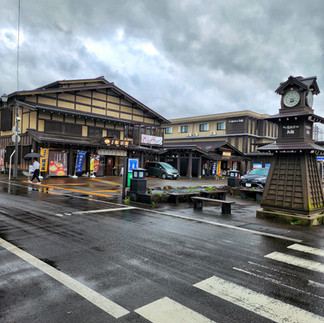Japan Unveiled: A Journey of Culture, Cuisine & Technology
- Disenyo 4 U

- Jul 6, 2024
- 8 min read
Updated: Jul 7, 2024

Visiting Japan has always been a dream of mine. I admire the simplicity & elegance of their homes, the tranquility of their Zen gardens, and the discipline & work ethics of the Japanese people.
In 2024, I finally made this dream a reality. Originally planning a vacation to the Philippines, I found that summer flight tickets were quite expensive. However, I discovered that flying to Japan was significantly cheaper than a direct flight to Manila. So, we decided to book a flight to Japan first and then another to Manila. Here’s how our itinerary unfolded:
The Flight to Japan

Our adventure began with a flight from Newark to Tokyo, which was delayed due to a technical problem. About 2.5 hours into the flight, the plane turned back while over Canada, adding another three hours to return to Newark. Thankfully, our dependable credit cards allowed us to use the lounges while waiting for a new plane. We eventually flew out that day but missed our connecting flight from Tokyo to Osaka. Having travel insurance is crucial in instances like these delays, as it provides financial protection and assistance for unexpected expenses and inconveniences during times like this.

We stayed overnight at the Villa Fontaine Hotel in Haneda Airport. The hotel, with its direct airport access and free shuttle buses, was incredibly convenient and provided much-needed relaxation after our long-haul flight. The next morning, I started to feel the effects of fatigue and delayed flights, I started to sneeze.
Osaka: First Impressions
We flew to Osaka the next morning on ANA Airlines. The serene and quiet flight, with a pristine cabin and a clear view of Mt. Fuji, was my first full experience of Japanese hospitality.
With four large suitcases, we found it convenient to store them for a fee at the airport, a common and efficient service in Japan. We chose Shin Osaka Washington Hotel for its free shuttle from the airport and nearby convenience store, train station and pharmacy, which was a lifesaver as my flu worsened.

The pharmacy provided a Japanese medicine, which despite the language barrier, worked wonders. By afternoon, I felt significantly better, a stark contrast to my usual recovery time from a runny nose.
Exploring Osaka
That evening, we took the train to Dotonbori for dinner. We chose Wanomiya Kobe Beef restaurant, renowned for its teppanyaki and Kobe beef. Prepared by Chef Yo, the Kobe beef was extraordinary—tender, flavorful, and truly a must-try.
As written in their restaurant, here is how a Kobe Beef is made: First, Tajima cows are born and raised in Hyogo Prefecture. They must be pure blood pedigree. Then, when they are between 2 to 5 years old, they have to meet the strictest standards in the world. Not all Tajima cows meet these rules. Finally, the Tajima cows that do meet the standards become Kobe beef. It's quite a journey for those cows!
After this delightful meal, we paused our Japan exploration to head to the Philippines for two weeks.
Return to Osaka

Fourteen days later, we were back in Osaka, this time staying at Hotel Nikko which is highly regarded for its convenient location near major train stations and airport, offering easy access to transportation, comfortable accommodations, excellent amenities, and particularly ideal for travelers with early flights and lots of luggage.
There is a restaurant near the hotel which featured a robotic server at its restaurant, where I enjoyed an exceptional squid pasta.

With a JR Express Green Card Pass, we planned extensive travels across Japan, ensuring comfort on our journeys. The JR Express Green Pass provides travelers in Japan with a comfortable and convenient way to explore the country's extensive rail network, offering unlimited access to reserved seats on JR trains, including the shinkansen (bullet trains). It's particularly beneficial for those seeking hassle-free travel across various regions of Japan, ensuring comfort and flexibility throughout their journey.
Shopping and Sightseeing
Our first stop was shopping at Don Quixote, famous for its wide range of affordable, high-quality Japanese products. Beauty items like foot patches, honey hair serum, and propolis mouthwash were my favorites. A must-try street food in Osaka is Takoyaki, is a popular Japanese street food, consists of octopus pieces cooked in a savory batter, shaped into round balls, and topped with various sauces and toppings.
Dinner at a subway restaurant introduced me to authentic ramen, the ramen, as most of us know is a beloved Japanese noodle soup dish featuring wheat noodles in a flavorful broth, typically garnished with ingredients like sliced pork, soft-boiled eggs, seaweed, and green onions.
Kyoto: A Cultural Experience
We traveled to Kyoto via the Hello Kitty-themed Haruka train and stayed at Hotel Miyako, conveniently close to the station. Our first destination was the Fushimi Inari Shrine, renowned for its stunning series of Torii gates, perfect for Instagram. The shrine is dedicated to Inari, the Shinto god of rice, and is famous for its thousands of vermilion torii gates leading up the forested mountain.
Late in the afternoon, we eagerly set out to catch a glimpse of Nijo Castle. We took a taxi, but luck wasn’t on our side, and we arrived at the gate at 4:45 p.m., just as admissions had closed. Adding to our dismay, Jason, my husband, discovered his phone was missing, likely having slipped out in the taxi. Amidst the sinking feeling of despair, we found solace in the fact that payphones are still prevalent in Japan. We made a call to the taxi operator, who miraculously found the phone and returned it to our hotel. In that moment, we realized how incredibly fortunate we were to be in Japan, a place where honesty and helpfulness are woven into the fabric of everyday life—an outcome that might have been a distant hope elsewhere.
That evening, we explored the Gion district, known for its historical Geisha culture. Gion is one of the most famous geisha districts in Japan, with its traditional wooden machiya houses and teahouses where you can spot geishas. The next morning, we visited the serene To-Ji Temple for some quiet reflection. To-Ji Temple, a UNESCO World Heritage site, is home to Japan's tallest wooden pagoda and an important cultural symbol with its beautiful gardens and historic buildings.
Tokyo: Urban Adventures
Taking another train to Tokyo, we stayed at Hilton Tokyo, enjoying perks like an upgraded room, Executive Lounge access, and complimentary breakfast thanks to our Amex card. On our first day in Tokyo, we opted for a relaxing spa experience and a dip in the pool before indulging in a sumptuous Japanese dinner.
Exploring Tokyo via Sky Hop Bus, we visited key tourist spots, including the famous Shibuya Crossing and Hachiko Memorial Statue. Shibuya Crossing is known as the busiest pedestrian crossing in the world, where thousands of people cross simultaneously.


The Hachiko statue commemorates the loyal Akita dog who waited for his owner every day at Shibuya Station, even after his owner's death.
The Sky Hop Bus in Tokyo stops at several key locations: Marunouchi Mitsubishi Building and Tokyo Station, both of which are central transport hubs; Ueno Station, close to Ueno Park and museums; Asakusa Hanakawado, near the famous Senso-ji Temple; Tokyo Skytree, offering panoramic city views; and Ryogoku, home to the sumo wrestling stadium. It also stops at Tokyo Tower, an iconic landmark; Roppongi Hills and Tokyo Midtown, known for shopping and entertainment; Shibuya Station, famous for the Hachiko statue and Shibuya Crossing; and Meiji Jingu Shrine and Harajuku, popular for cultural and fashion experiences. Additionally, it visits Shinjuku Station and Kabukicho, known for nightlife; Isetan Department Store for upscale shopping; and the Imperial Palace, the residence of Japan's Imperial Family. Though it was raining that time, it didn't stop us from enjoying the ride, which felt like we were in a roller coaster as the train went through the skyway.
Kakunodate, Akita: Historical Insights
We journeyed north to Kakunodate in Akita to explore the Samurai Houses. Known as the "Little Kyoto of Tohoku," Kakunodate is famous for its well-preserved samurai residences and cherry blossom trees.

Staying at Hotel Folkloro, located conveniently next to Kakunodate train station, offers comfortable accommodations with a traditional Japanese ambiance and modern amenities.
We visited the Kawarada Samurai House, one of the many historical samurai houses open to the public. Itis a well-preserved historical residence that showcases the lifestyle and architecture of the samurai class during the Edo period. Visitors can explore its traditional rooms, beautiful gardens, and artifacts, gaining insight into the samurai culture and history.
We also met two adorable Akita dogs, Su-chan and Fujiko, at a local house. The adorable akita dogs reside in one of the samurai houses in Kakunodate, delighting visitors with their friendly and gentle demeanor. These well-cared-for dogs are a living testament to the revered Akita breed, known for their loyalty and distinctively beautiful appearance.
Despite early restaurant closures on Mondays, our hotel restaurant provided delicious Inaniwa Udon noodles, Kiritanpo Nabe, and unique soy sauce and Sakura ice creams.
The following day, we visited the Aoyogi Samurai Residence, the largest samurai house in Kakunodate, featuring beautiful gardens and historical artifacts. We then cooled off at Hinokinai River before enjoying lunch at Sakura No Sato, a charming restaurant along the Samurai district.

Onsen Experience

Desiring an authentic onsen experience, we visited a quaint town and Onsen Yupopo. Initially shocked by the nudity, the friendly local women guided me through the process, resulting in a truly relaxing experience. Onsens are traditional Japanese hot spring baths, renowned for their therapeutic benefits and cultural significance.
Final Stop: Osaka Castle
Before heading to KIX Airport and back to Hotel Nikko, we visited Osaka Castle, a magnificent historical landmark built in the late 16th century by Toyotomi Hideyoshi. It played a major role in the unification of Japan during the Azuchi-Momoyama period.
Our final evening in Japan was spent reminiscing about the incredible journey—filled with amazing food, kind people, rich culture, and advanced technology. Japan, with its cleanliness, respectfulness, and convenience, stood out as the best country I’ve ever visited. Despite the language barrier, tools like Google Lens and Translate made communication easy. Relying on my credit card for points and tracking expenses, while my husband used cash and an IC card, made our travels smooth and efficient.
Japan is renowned for its exceptional cleanliness, with streets, public spaces, and transportation systems meticulously maintained. It is common to see people rigorously cleaning, from business owners sweeping the sidewalks to dedicated staff ensuring every corner remains spotless.

We stayed in a 3-star, 4 star and 5-star hotels, and I noticed that Japan maintains a high standard of amenities. Guests can consistently expect to find slippers, robes, three bottles in the shower containing shampoo, conditioner, and body wash, a flashlight, an air purifier, a range of toiletries, and an air freshener. This uniformity ensures a comfortable and well-equipped stay at any level of accommodation.
To top it all, one of the best things about Japan is the clean toilets and the high-tech bidets. Every restroom, whether in a hotel, airport, or public space, is immaculately clean, and the bidets with various functions made the experience exceptionally comfortable and hygienic.
As Jason and I sat reminiscing about our incredible journey through Japan, we couldn't help but marvel at how different this country felt compared to the rest of the world. "Why is Japan so unique, setting the bar so high?" I pondered.
Jason smiled, reflecting on our experiences. "It's because of the people," he replied thoughtfully. "Look at how disciplined, hardworking, and passionate they are about their work. They work silently, but the outcomes are always remarkable."
As we watched the lights of Osaka flicker in the distance, I realized he was right. The spirit of Japan's people—respectful, dedicated, and quietly diligent—truly makes this country extraordinary. It was clear that their unwavering commitment to excellence in everything they do is what sets Japan apart, making it a place we will always cherish and long to return to.
Sayonara, Japan! You are now my favorite, and I hope to see you again soon.




















































































































































































Comments